#potato farmer art
Text

boop but make it tensimm
#the boop has taken over my brain#they have as well#tensimm#10th doctor#tenth doctor#thoschei#art#fanart#doctor who#simm!master#potato farmer art#the master#the doctor#i coulndt bother with hands today-
339 notes
·
View notes
Text

Meanwhile, in some other dimension.
1K notes
·
View notes
Text

Not me re-watching Potato War for the millionth time because of content deprivation, also happy birthday to our boi🎉
#Farmer Techno my beloved#i miss technoblade#technoblade fanart#technoblade#techno#techno fanart#dsmp#dream smp#dream smp fanart#dsmp fanart#mcyt#mcyt fanart#Potato war#fan art#my art
2K notes
·
View notes
Text

Rarold moment!! 🌽🐱❤️
#i stopped counting how many times i drew that corn farmer#be kind my neighbor#bkmn#rarold#bkmn rarold#rarold bkmn#kevin#potato#(she's there!!!)#art#procreate#jooj draws
78 notes
·
View notes
Text
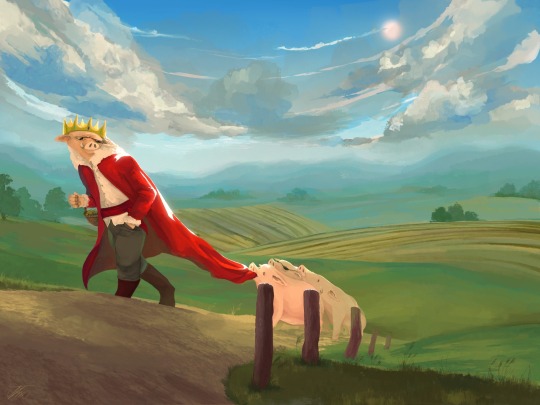
A humble potato farmer
#technoblade#technofanart#art#technoblade never dies#technoblade number 1 potato farmer#technoblade potato farmer#potato war#potatowar#technoblade potato war
111 notes
·
View notes
Text
// mpreg , pregnancy
There’s something intensely hilarious and fitting about imagining a Wei Wuxian who, as Wei Wuxian does, finds a way to get himself pregnant, only to act like a Harvest Moon/Stardew Valley farmer and go about business as usual. Pregnant Wei Wuxian out in the fields tending to his crops as if nothing was different.
#mpreg /#pregnancy mention /#mdzs textpost not art#I love Wei Wuxian having a little farm post canon and thinking about it just made me think of this scenario#bc Fr why does the female farmer character of these work still when they’re pregnant in these games 😭😭#can you imagine being lwj here like ‘wei ying please rest’ ‘but lan zhan my potatoes need watering :(‘#wwx 100% the guy who chatters nonstop to his plants#they’re very healthy and happy#turns out it was a miracle itself to grow anything at all in burial mounds#so anywhere else is much easier to grow things#including the life inside wwx 😌#of course he doesn’t do super hard manual labor the closer to term he is since he knows better#but if it’s just himself that’s achy then he’ll just deal and whine dramatically later 😌#also imagine he still goes on night hunts with the juniors and laughs as they make him stand farrr back#as if he needs to be close to fight lol#mdkdkdk this was just a random thought don’t mind me
327 notes
·
View notes
Photo

GLEP
PEePPAROOoOooOoNI
Twitter - DeviantArt - NewGrounds - FurAffinity - Tumblr
Posted using PostyBirb
#pizza tower#pizzatower#pillar john#potato farmer#cheese slime#rat#u.f.olive#forknight#pepperoni goblin#bomb#pizza#pizzard#pencer#bandito chicken#pinacool#anchovy#banana peel#pizzaboy#fan art#splash page#it's pizza time#weenie#pizzatowergame
148 notes
·
View notes
Photo
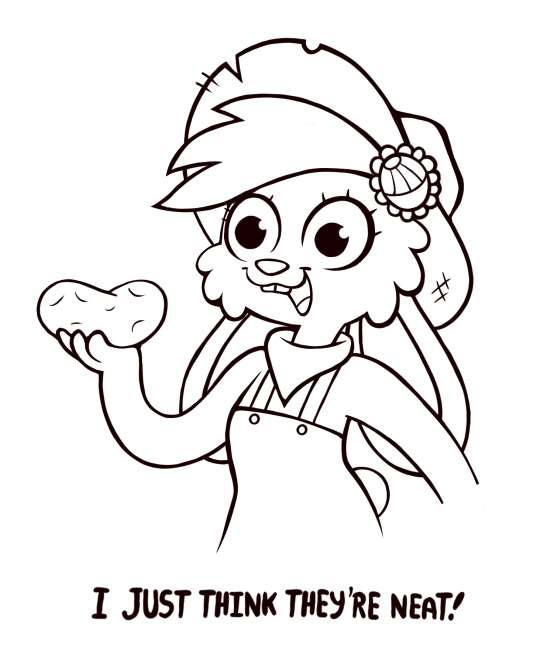
Tater has opinions on Tubers. 🐰🥔
Tater Swizzle belongs to @waffled0g and shuffle!
77 notes
·
View notes
Photo

Big Tater
Art Fight 17: For this installment I drew a character I've admittedly wanted to draw for a while, @waffledog's Tater Swizzle. She's a cute farmer bun, and I'm happy I finally had the chance to draw her. Y'all be nice to her, ya' here.
Posted using PostyBirb
#tater#tater swizzle#potato#farmer#female#bunnygirl#bunny#rabbit#girl#bunny girl#woman#lady#pembrokewkorgi#artfight#art fight
20 notes
·
View notes
Text
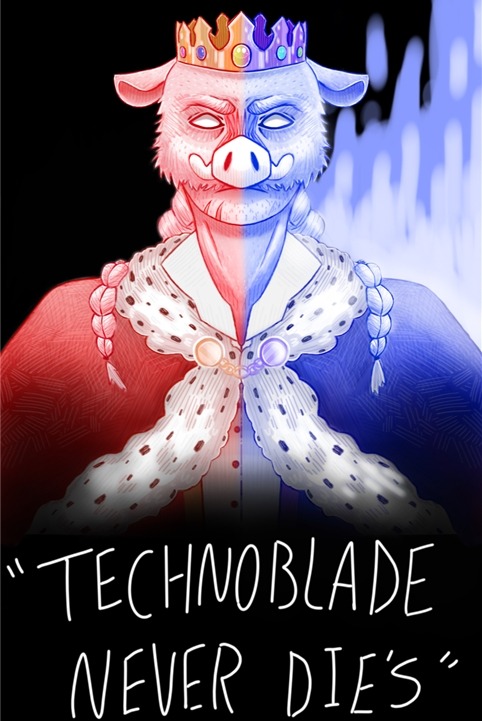
RIP
#technoblade#rest in peace#technoblade never dies#i miss technoblade#technofanart#artsists on tumblr#digital drawing#art#fuck cancer#rip technoblade#the man the myth the legend#humble potato farmer#fanart#heaven has gained another angle
45 notes
·
View notes
Text

Sweet potato butterfly Gumby, dammit
#food art#sweet potatoes#I am gumby dammit#farmers market#local food#love for imperfect things#not safe to eat#playing with food
0 notes
Text

messy tensimm sketch! they are eeping
#doctor who#fanart#thoschei#tensimm#tenth doctor#simm!master#10th doctor#they have taken over my brain#potato farmer art
277 notes
·
View notes
Text



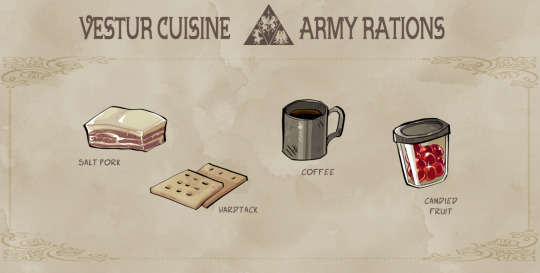
Foods of Vestur
@broncoburro and @chocodile provoked me into doing some illustrated worldbuilding for Forever Gold ( @forevergoldgame ), an endeavor I was happy to undertake. Unbeknownst to me, it would take the better part of a week to draw.
In the process, I conjured about an essay's worth of fantasy food worldbuilding, but I'm going to try and keep things digestible (pardon my pun). Lore under the cut:
The Middle Kingdom
The Middle Kingdom has ample land, and its soil, landscapes, and temperate climate are amenable to growing a variety of crops and raising large quantities of livestock. The Midland palate prefers fresh ingredients with minimal seasoning; if a dish requires a strong taste, a cook is more likely to reach for a sharp cheese than they are to open their spice drawer. Detractors of Middle Kingdom cuisine describe it as bland, but its flavor relies on the quality of its components more than anything.
KEY CROPS: wheat, potatoes, carrots, green beans, apples, pears, and grapes
KEY LIVESTOCK: Midland goats, fowl, and hogs
ROAST FOWL: Cheap and easy to raise, fowl is eaten all over Vestur and by all classes. Roasted whole birds are common throughout, but the Middle Kingdom's approach to preparation is notable for their squeamish insistence on removing the head and neck before roasting, even among poorer families. Fowl is usually roasted on a bed of root vegetables and shallots and served alongside gravy and green beans.
GOAT RIBEYE: Vestur does not have cattle – instead it has a widely diversified array of goats, the most prominent being the Middle Kingdom's own Midland goat. The Midland goat is a huge caprid that fills the same niche as cattle, supplying Vestur with meat and dairy products. Chevon from the Midland goat is tender with a texture much like beef, though it retains a gamier, “goat-ier” taste. It is largely eaten by the wealthy, though the tougher and cheaper cuts can be found in the kitchens of the working class. Either way, it is almost always served with gravy. (You may be sensing a pattern already here. Midlanders love their gravy.)
FETTUCCINE WITH CHEESE: Noodles were brought to the Middle Kingdom through trade with the South and gained popularity as a novel alternative to bread. The pasta of Midland Vestur is largely eaten with butter or cream sauce; tomato or pesto sauces are seldom seen.
CHARCUTERIE WITH WINE: Charcuterie is eaten for the joy of flavors rather than to satiate hunger, and therefore it is mainly eaten by the upper class. It is commonly eaten alongside grape wine, a prestigious alcohol uniquely produced by the Middle Kingdom. The flavor of grape wine is said to be more agreeable than the other wines in Vestur, though Southern pineapple wine has its share of defenders.
BREAD WITH JAM AND PRESERVES, TEA SANDWICHES, & ROSETTE CAKE: Breads and pastries are big in the Middle Kingdom. The Middle Kingdom considers itself the world leader in the art of baking. Compared to its neighbors, the baked goods they make are soft, light, and airy and they are proud of it. Cakes in particular are a point of ego and a minor source of mania among nobility; it is a well-established cultural joke that a Middle Kingdom noble cannot suffer his neighbor serving a bigger, taller cake. The cakes at Middle Kingdom parties can reach nauseatingly wasteful and absurdist heights, and there is no sign of this trend relenting any time soon.
CHOWDER, FARMER'S POT PIE, GRIDDLECAKES, EGGS, CURED MEATS: If you have the means to eat at all in the Middle Kingdom, you are probably eating well. Due to the Midland's agricultural strength, even peasant dishes are dense and filling. Eggs and cured meats are abundant, cheaper, and more shelf stable than fresh cuts and provide reprieve from the unending wheat and dairy in the Midland diet.
STEWED APPLES AND PEARS, JAM AND PRESERVES: The Midland grows a number of different fruits, with apples and pears being the most plentiful. In a good year, there will be more fruit than anyone knows what to do with, and so jams and preserves are widely available. Stewed fruit has also gained popularity, especially since trade with the Southern Kingdom ensures a stable supply of sugar and cinnamon.
NORTHERN KINGDOM - SETTLED
The Northern Kingdom is a harsh and unforgiving land. Historically, its peoples lived a nomadic life, but since the unification of the Tri-Kingdom more and more of the Northern population have opted to live a settled life. The “settled North” leads a hard life trying to make agriculture work on the tundra, but it is possible with the help of green meur. The Northern palate leans heavily on preserved and fermented foods as well as the heat from the native tundra peppers. Outsiders often have a hard time stomaching the salt, tang, and spice of Northern cuisine and it is widely considered “scary.”
KEY CROPS: potatoes, beets, carrots, tundra pepper
KEY LIVESTOCK: wooly goats, hares*
GOAT POT ROAST: Life up north is hard work and there is much to be done in a day. Thus, slow cooked one-pot meals that simmer throughout the day are quite common.
VENISON WITH PICKLES: Game meat appears in Northern dishes about as much as farmed meat – or sometimes even more, depending on the location. Even “classier” Northern dishes will sometimes choose game meat over domesticated, as is the case with the beloved venison with pickles. Cuts of brined venison are spread over a bed of butter-fried potato slices and potent, spicy pickled peppers and onions. The potatoes are meant to cut some of the saltiness of the dish, but... most foreigners just say it tastes like salt, vinegar, and burning.
MINER STEW: While outsiders often have a hard time distinguishing miner stew from the multitude of beet-tinged stews and pot roasts, the taste difference is unmistakable. Miner's stew is a poverty meal consisting of pickles and salt pork and whatever else is might be edible and available. The end result is a sad bowl of scraps that tastes like salt and reeks of vinegar. The popular myth is that the dish got its name because the Northern poor began putting actual rocks in it to fill out the meal, which... probably never happened, but facts aren't going to stop people from repeating punchy myths.
RYE TOAST WITH ONION JAM: Rye is hardier than wheat, and so rye bread is the most common variety in the North. Compared to Midland bread, Northern bread is dense and gritty. It is less likely to be enjoyed on its own than Midland bread, both because of its composition and because there's less to put on it. Unless you've the money to import fruit spreads from further south, you're stuck with Northern jams such as onion or pepper jam. Both have their appreciators, but bear little resemblance to the fruit and berry preserves available elsewhere in Vestur.
HARE DAIRY: Eating hare meat is prohibited in polite society due to its association with the haretouched and heretical nomadic folk religions, but hare dairy is fair game. Hare cheese ranges from black to plum in color, is strangely odorless, and has a pungent flavor akin to a strong blue cheese. It is the least contentious of hare milk products. Hare milk, on the other hand, is mildly toxic. If one is not acclimated to hare milk, drinking it will likely make them “milk sick” and induce vomiting. It is rarely drunk raw, and is instead fermented into an alcoholic drink similar to kumis.
MAPLE HARES AND NOMAD CANDY: Maple syrup is essentially the only local sweetener available in the North, and so it is the primary flavor of every Northern dessert. Simple maple candies are the most common type of sweet, though candied tundra peppers – known as “nomad candy” – is quite popular as well. (Despite its name, nomad candy is an invention of the settled North and was never made by nomads.)
TUNSUKH: Tunsukh is one of the few traditions from the nomadic era still widely (and openly) practiced among Northern nobility. It is a ceremonial dinner meant as a test of strength and endurance between political leaders: a brutally spiced multi-course meal, with each course being more painful than the last. Whoever finishes the dinner with a stoic, tear-streaked face triumphs; anyone who cries out in pain or reaches for a glass of milk admits defeat. “Dessert” consists of a bowl of plain, boiled potatoes. After the onslaught of tunsukh, it is sweeter than any cake.
NORTHERN KINGDOM – NOMADIC NORTH
Although the Old Ways are in decline, the nomadic clans still live in the far North beyond any land worth settling. They travel on hareback across the frozen wasteland seeking “meur fonts” - paradoxical bursts of meur that erupt from the ice and provide momentary reprieve from the harsh environment. The taste of nomad food is not well documented.
KEY CROPS: N/A
KEY LIVESTOCK: hares
PEMMICAN: Nomadic life offers few guarantees. With its caloric density and functionally indefinite “shelf life,” pemmican is about as close as one can get.
SEAL, MOOSE: Meat comprises the vast majority of the nomadic diet and is eaten a variety of ways. Depending on the clan, season, and availability of meur fonts, meat may be cooked, smoked, turned to jerky, or eaten raw. Moose and seal are the most common sources of meat, but each comes with its own challenges. Moose are massive, violent creatures and dangerous to take down even with the aid of hares; seals are slippery to hunt and only live along the coasts.
WANDER FOOD, WANDER STEW: When a green meur font appears, a lush jungle springs forth around it. The heat from red meur fonts may melt ice and create opportunities for fishing where there weren't before. Any food obtained from a font is known as “wander food.” Wander food is both familiar and alien; the nomads have lived by fonts long enough to know what is edible and what is not, but they may not know the common names or preparation methods for the food they find. Fish is simple enough to cook, but produce is less predictable. Meur fonts are temporary, and it's not guaranteed that you'll ever find the same produce twice - there is little room to experiment and learn. As a result, a lot of wander food is simply thrown into a pot and boiled into “wander stew,” an indescribable dish which is different each time.
CENVAVESH: When a haretouched person dies, their hare is gripped with the insatiable compulsion to eat its former companion... therefore, it is only proper to return the favor. Barring injury or illness, a bonded hare will almost always outlive its bonded human, and so the death of one's hare is considered a great tragedy among nomads. The haretouched – and anyone they may invite to join them – sits beside the head of their hare as they consume as much of its rib and organ meat as they can. Meanwhile, the rest of the clan processes the remainder of the hare's carcass so that none of it goes to waste. It is a somber affair that is treated with the same gravity as the passing of a human. Cenvavesh is outlawed as a pagan practice in the settled North.
HARE WINE: While fermented hare's milk is already alcoholic, further fermentation turns it into a vivid hallucinogen. This “hare wine” is used in a number of nomad rituals, most notably during coming of age ceremonies. Allegedly, it bestows its drinker with a hare's intuition and keen sense of direction... of course, truth is difficult to distinguish from fiction when it comes to the Old Ways.
SOUTHERN KINGDOM
The Southern Kingdom is mainly comprised of coast, wetland, and ever-shrinking jungle. While the land is mostly unfit for large-scale agriculture, seafood is plentiful and the hot climate is perfect for exorbitant niche crops. What they can't grow, they obtain easily through trade. Southerners have a reputation for eating anything, as well as stealing dishes from other cultures and “ruining” them with their own interpretations.
KEY CROPS: plantains, sweet potato, pineapple, mango, guava, sugarcane
KEY LIVESTOCK: fowl, marsh hogs, seals
GLAZED EEL WITH FRIED PLANTAINS: A very common configuration for Southern food is a glazed meat paired with a fried vegetable. It almost doesn't matter which meat and which vegetable it is – they love their fried food and they love their sweet and salty sauces in the South. Eel is a culturally beloved meat, much to the shock and confusion of visiting Midlanders.
NARWHAL STEW: Narwhal stew is the South's “anything goes” stew. It does not actually contain narwhal meat, as they are extinct (though the upper class may include dolphin meat as a protein) – instead, the name comes from its traditional status as a “forever soup,” as narwhals are associated with the passage of time in Southern culture. Even in the present day, Southern monasteries tend massive, ever-boiling pots of perpetual stew in order to feed the monks and sybils who live there. Narwhal stew has a clear kelp-based broth and usually contains shellfish. Beyond that, its ingredients are extremely varied. Noodles are a popular but recent addition.
FORAGE: The dish known as “forage” is likewise not foraged, or at least, it hasn't been forage-based in a good hundred years at least. Forage is a lot like poke; it's a little bit of everything thrown into a bowl. Common ingredients include fish (raw or cooked), seaweed, fried noodles, marinated egg, and small quantities of fruit.
HOT POT: Hot pot is extremely popular, across class barriers, in both the South proper and its enclave territories. This is due to its extreme flexibility - if it can be cooked in a vat of boiling broth, it will be. Crustaceans and shellfish are common choices for hot pot in the proper South, along with squid, octopus, mushrooms, and greens.
FLATBREAD: The Southern Kingdom doesn't do much baking. The vast majority of breads are fried, unleavened flatbreads, which are usually eaten alongside soups or as wraps. Wraps come in both savory and sweet varieties; savory wraps are usually stuffed with shredded pork and greens while sweet wraps – which are much more expensive – are filled with fruit and seal cheese.
GRILLED SKEWERS, ROAST SWEET POTATO: While a novel concept for Midlanders and Northerners, street food has long been a part of Southern Kingdom culture. You would be hard pressed to find a Southern market that didn't have at least three vendors pushing grilled or fried something or other. Skewers are the most common and come in countless configurations, but roast sweet potatoes are a close second.
CUT FRUIT AND SEAL CHEESE: Fresh fruit is popular in the South, both local and imported. While delicious on its own, Southerners famously pair it with seal cheese. Which leads me to an important topic of discussion I don't have room for anywhere else...
THE SOUTH AND CHEESE: Since the South doesn't have much in the way of dairy farming, cheese is somewhat rare in their cuisine – but it is present. And important. Cheese is the domain of the Church. Common goat dairy imported from the Middle Kingdom is turned to cheese by monks in Southern monasteries and sold to the Southern public, yes, but as you have noticed there is another cheese prominent in the Southern Kingdom diet: seal cheese. Seal cheese is unlike anything else that has ever been called cheese; the closest it can be compared to is mascarpone. It is is a soft, creamy cheese with a mild flavor and an indulgent fat content. It is used almost exclusively as a dessert, though it is only ever mildly sweetened if at all. It is extremely costly and held in high regard; the most religious Southerners regard it as holy. Dairy seals are a very rare animal and raised exclusively in a small number of Cetolist-Cerostian monasteries, where they are tended and milked by the monks. Due to their status as a holy animal, eating seal meat is forbidden. Eating their cheese and rendering their tallow into soap is fine though.
(HEARTLAND SOUTH) SOUTH-STYLE GOAT: The Heartland South is a Southern enclave territory in the Middle Kingdom. Visiting Midland dignitaries oft wrongly assume that because the Heartland South is in Middle Kingdom territory, Heartland Southerners eat the same food they do exactly as they do. They are horrified to find that familiar sounding dishes like “goat with potatoes” are completely and utterly unrecognizable, drenched in unfamiliar sauces and spices and served alongside fruit they've never eaten. Meanwhile, Heartland Southerners firmly believe that they have fixed the Middle Kingdom's boring food.
(BOREAL SOUTH) “TUNSUKH”: If Midlanders are afraid of Heartland Southern food, Northerners are absolutely furious about cuisine from the Boreal South - the most legendarily offensive being the Boreal South's idea of “tunsukh.” Southerners are no stranger to spice, so when Southern traders began interacting with the North, they liked tunsukh! It's just... they thought it needed a little Southern help to become a real meal, you know? A side of seal cheese soothed the burn and made the meal enjoyable. And because the meal was enjoyable, the portion sizes increased. And plain boiled potatoes? Well, those are a little too plain – creamy mashed sweet potato feels like more of a dessert, doesn't it? ...For some reason, Northerners didn't agree, but that's okay. The Boreal South knows they're just embarrassed they didn't think of pairing seal cheese with tunsukh sooner.
ARMY RATIONS
The food eaten by the King's Army is about what you would expect for late 1700s military; salt pork or salt chevon, hard tack, and coffee. The biggest divergence they have is also one of Vestur's biggest points of pride: they have the means to supply their troops with frivolous luxuries like small tins of candied fruit from the Midland. A love of candied fruit is essentially a Vesturian military proto-meme; proof that they serve the greatest Tri-Kingdom on the planet. Don't get between a military man and his candied fruit unless you want a fight.
#verse: forever gold#worldbuilding#fantasy worldbuilding#food worldbuilding#fantasy food#food art#animal death//#might have to proofread this later forgive any typos I am tired
558 notes
·
View notes
Text
Oh my god I woke up this morning and my Stardew Valley meta post had almost 150 notes????? Hello?????????? Anyways I started writing this last night because @moon-is-pretty-tonight left nice tags on the original so thank you so much!!
We know from the starting scenes of the game that the farmer's grandfather loved Stardew Valley. So why did he leave? Pelican Town is a good place to grow old; George and Evelyn are just fine. It's a fine place to raise a kid, but maybe he just wanted to raise his child closer to real schools and other children.
Or maybe, just maybe, he understood.
Was there a day when he was in his thirties where he looked at his friends and realized they weren't like him? That he could run faster than them, work longer, explore deeper into the hidden places of the valley?
Was there a day when he went to the wizard to ask him for help, for knowledge if nothing else? Did he learn then that his family was different? Special? Chosen? And how did he react? He couldn't possibly raise a child in the valley if they would be as strange and fey as him. He had to leave. There was no other way.
But years later, on his deathbed, did he regret that choice?
Is that why he gave the farmer the letter?
Is that why they went back home?
When the farmer steps off the bus that first day, the valley is still on the cusp of winter, just barely tipping over into spring. The flowers are starting to bloom, but a chill still hangs in the air. As soon as the farmer's boots touch the soil there's a change. The air gets warmer. The trees get greener. Not by too much, not all at once, but it changes.
The junimos watch the farmer as they do their work. They're new to farming, but take to it with frightening speed; their first batch of crops is perfect. None of the townsfolk tell them that parsnips don't normally grow in less than a week, that cauliflowers don't grow to be ten feet tall, that fairies don't visit when the sun goes down and grow potatoes and beans and tulips overnight. The junimos talk amongst themselves in their strange, wild language, and agree: this is the one. They're back. The valley recognizes its own, even when they've left for a generation. The farmers have come home.
Things change fast in the valley. The community center, empty and decrepit for so many years, is rejuvenated. (Lewis says it was abandoned only a few weeks after the farmer's grandfather left. Strange coincidence, he says, that it both came and went with the farmer's family.) The mines and the quarry, similarly abandoned, are explored for the first time in ages. The town becomes cleaner, brighter, more vibrant, happier.
And it is happier. Not just the environment, but the people. It's the talk of the town for weeks when Haley does her first closet purge. Leah's art show in the town square is a huge success. Shane's smiling for the first time since he moved to the valley. All of them, when asked, say it's all thanks to the farmer.
People love to ask why Lewis didn't fix the community center on his own. Why Willy never repaired the boat to ginger island. Why Abigail or Marlon never went down to fix the elevator in the mines, or why Clint didn't fix the minecarts.
But isn't it so much more interesting to ask how those things were there in the first place? How they got so broken down? If the stories the townspeople tell are true, the valley was once a beautiful place, flourishing and full of life; why did that change? When did it change?
Was it when the farmer's grandfather, the locus of the valley, its chosen representative, left town?
And if so, what happens when the farmer comes back?
#lich says shit#stardew valley#stardew farmer#sdv#my writing#Hope y'all enjoyed!#I'm thinking about developing this into. Like. An actual Fan Fiction. Still sort of short-form but like with more detail?#LMK if you'd be interested to see that! Also if you want to be tagged in future installations of this please just let me know :)#I'm super into this version of the farmer as like. Blessed and cryptic child of the valley with all the strange behavior that entails#If i DO write a more in-depth version of this it'll be from the perspective of someone in town#maybe Leah? She seems like she'd be the one to notice the farmer being Odd. Either that or I'll do it from the perspective of multiple--#--different people to get their unique insights and stuff#I'd also want to dig into like#The family history of the farmer. And what that's like.#Because like why did grandpa leave?#He clearly loved the valley#So why didn't he stay?#Why did he give the deed to his grandchild and not his literal child?#And is it a coincidence that everything in the valley went downhill when he left?#I don't think so.
152 notes
·
View notes
Text
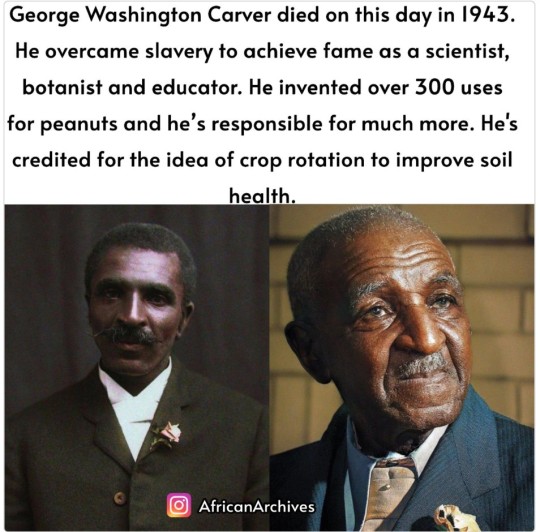
George Washington Carver had a difficult start in life. His father died shortly before his birth And weeks later, slave traders kidnapped him and his mother. The group sent out to find him and his mother exchanged a horse for the young boy. His mother, however, was lost to the traders.
Often sick, frail, he was not expected to live. But live he did, and from a young age, he showed much devotion to work and a desire for learning. He was curious, and as he'd roam the woods near the Carver home, exploring flowers, trees, rocks, and birds, he began asking questions about their purpose.
While much of his education early on was self-motivated, he began formal schooling at ten. He learned of a school about eight miles from the Carver home. And without any money or a new home, he left the Carver's to attend this school, living in an old barn while doing odd jobs to earn money to survive. Eventually, he was adopted into a family there.
Education for George would continue through completing a Master's Degree in agriculture from Iowa State University in 1896. After which, he took a job as Head of the Agricultural Department at the Tuskegee Institute in Alabama.
George was also an artist. At the age of 30, Carver gained acceptance to Simpson College in Indianola, Iowa, where he was the first Black student. Carver studied piano and art.
As an agricultural scientist and inventor, his goal was to help farmers improve their lives by earning more from their crops. He found hundreds of uses through his research of peanuts in particular and other products such as sweet potatoes and pecans. His work was instrumental and impactful. Between 1915 and 1918, acreage for peanut cultivation grew from half a million to over four million acres.
After George passed away in 1943, Franklin D. Roosevelt sent a message that said: "All mankind are the beneficiaries of his discoveries in the field of agricultural chemistry. The things which he achieved in the face of early handicaps will for all time afford an inspiring example to youth everywhere."
Source: African Archives
275 notes
·
View notes
Text
Napoleonic era dashboard simulator

👑 le-emperor12 Follow
Just crowned myself Emperor. Will have fun restoring this country. Hello all.
🎨 daviddraws Follow
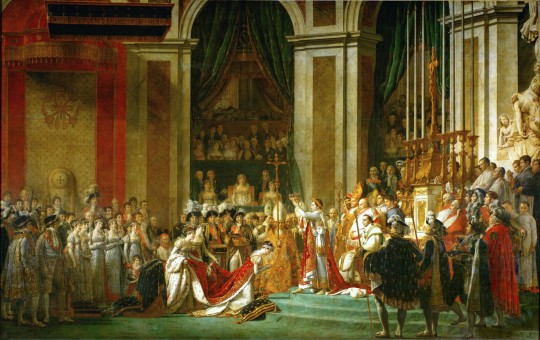
Love ur face
🥐 soft-fuzzy-french Follow
welcome to the throne slut <3
🎨 daviddraws Follow
Hey thats our Emperor like?? Plz have some more respect
🥐 soft-fuzzy-french Follow
im not french
12.5k Notes

Gals-Glitter-Glory-deacivated82725184
Marguerite Georges call out post ♡
I've been seeing a lot of fans of the Agrippina opera on my dash and it disappoints me that you still will support such an awful and vile woman. Georges is known to br the opposite of a "girls girl". She conflicts with all but herself. Not to mention her VARIOUS affairs with the tsar of Russia AND Napoleon, AND her lies of sleeping with the Duke of Wellington. For shame. Go unfolllow. Agrippina fans DNI.
🍑 mgeorges-offical Follow
saying i should be cancelled for not being a "girls girl" then slut shaming me is crazy tbh
🍑 mgeorges-offical Follow
SHE DEACTIVATED 😭😭
4,900 Notes

🇫🇷 best-french69 Follow

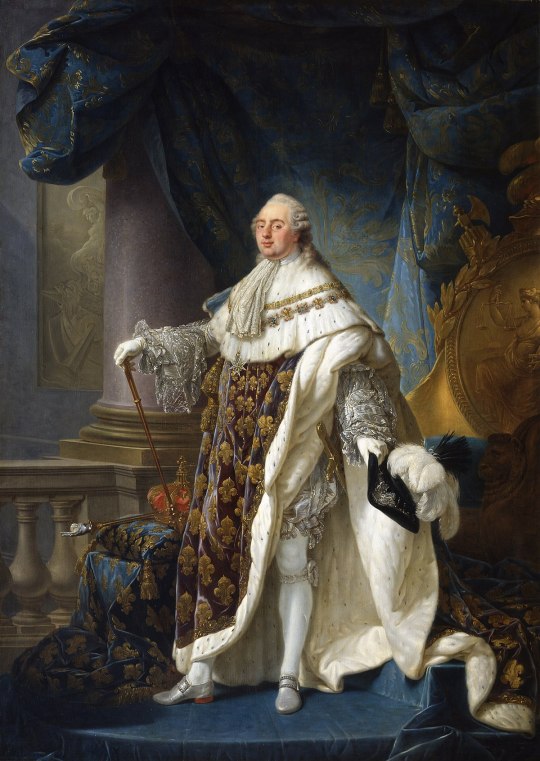
🥐 soft-fuzzy-french Follow
LETS GO SLUTS
67 Notes

🌹LaureJ Follow
Sometimes I feel like my husband doesnt love me... He writes to me like I was a nun, not a wife!
👑 le-emperor12 Follow
Lol look what he writes me
#ᵗᵃˡˡᵉʳʸʳᵃⁿᵈ ⁱᵍⁿᵒʳᵉ ᵗʰⁱˢ
424 Notes

🇬🇧 DukeOf-Wellington Follow
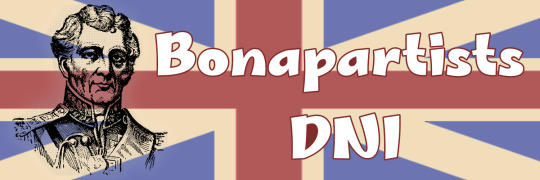
New header!
👑 le-emperor12 Follow
YOU THIBK UR SO GREAT CUZ YOU HABE BAOATS
🇬🇧 DukeOf-Wellington Follow
Dude... respect the DNI
6 Notes

✒️ Propaganda-Booty-Art Follow


JHSJSJS DONE WITH A NEW PIECE
✒️ Propaganda-Booty-Art Follow
hey guys. Why did alexander like and unlike this
68 notes

🇷🇺 romanovs-offical Follow
so my dad just got killed um
🇷🇺 romanovs-offical Follow
fml im gonna run away and become a potato farmer
DO NOT REBLOG
🇷🇺 romanovs-offical Follow
i miss my grandma
🇷🇺 romanovs-offical Follow
God doesnt hear me when i pray
🇷🇺 romanovs-offical Follow
every hoe on my dick
🇷🇺 romanovs-offical Follow
DO NOT FUCKIGN INTERACT RIGHT NOW!!!!!!!!!!!
🇷🇺 romanovs-offical Follow
WHO THE FUCK RESTORED THE BOURBON MONARCHY I TOLD YOU TTO CROWN NAPOLEON'S SON OHMYGOD
🇷🇺 romanovs-offical Follow
im sick lol

🇷🇺 romanovs-offical Follow
Hello, this is Nicholas, please ignore the posts before this, that was my brother, hes dead.
102 notes
·
View notes